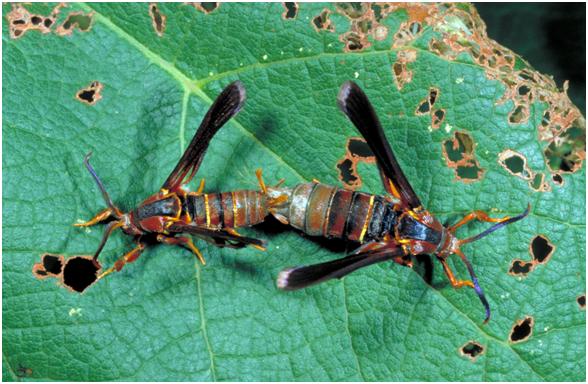Tomorrow, June 26, I will be kicking off the 2011 Grape Root Borer Volunteer Monitoring Network (GRB*VMN) at the NC Winegrowers Association summer picnic. I will be distributing trapping kits to volunteer growers and demonstrating trapping methods. For grape growers interested in monitoring for grape root borer who cannot attend the meeting, this post details how to monitor on your own. If you are interested in participating in the GRP*VMN, please contact me for more information.
The traps I use are available from Great Lakes IPM* and pheromone lures can be purchased from Arbico-Organics*.
Grape root borer (Vitacea polistiformis (Harris)) is potentially the most significant pest of grapes (both muscadine and Vinfera) in the southeast. Larvae have a 1 to 2 year life cycle, which means that injury, in the form of weakened and dying vines, often does not present for several years. Many of the Vinfera vineyards in the Carolinas and Georgia are reaching the 8 to 10 year mark, the time at which I anticipate grape root borer injury to become more apparent.
The GRB*VMN has two purposes:
1. To determine the density, range, and seasonal biology of grape root borer in North Carolina. In other words, to find out how many moths we have in our vineyards, which vineyards they are present in, and at what time of year they are active.
2. To give NC grape growers the skills to monitor for grape root borer and make management decisions based on monitoring information.
To accomplish these goals, we will train grape growers throughout the state to monitor for grape root borer adults on their farms and share their data through this blog.
Monitoring methods
We will place 4 universal moth traps per vineyard. Ideally, we will place these traps each in a different variety (if present). Within variety blocks, traps should be placed in low lying, wet areas, since these are at the highest risk of grape root borer infestation.
 |
| Pesticide strips placed in trap bottom. |
 |
| Trap top attached to bottom. |
Trap tops snap onto to trap bottoms.
 |
| Trap lid added to trap top. |
Trap lids keep rain and other debris out of the bottoms.
 |
| Grape root borer pheromone impregnated septa. |
Grape root borer pheromones are impregnated onto rubber septa and remain attractive for an entire field season.
 |
| Pheromone lure placed in pheromone container. |
Pheromone lures are placed into lidded containers.
 |
| Assembled trap. |
The pheromone container is inserted in the trap lid and hangs into the trap opening. Moths are attracted to pheromone lures and fall into the trap bottom where they are killed by the pesticide strip. Hangers are attached to trap lids, and traps are hung from canes or trellis wires.
 |
| Assembled grape root borer trap |
Traps are checked weekly and moths are counted. Pheromone lures are attractive at a long distance to male moths, and attractive at a short distance to females, so both sexes may be present in traps. Grape root borer moths resemble wasps but differ in that their wings are black and they lack the thin "waist" of wasps. After a few days in the traps, moths may appear darker brown (see below).
 |
| Mating male (left) and female (right) grape root borer moths. Photo: University of Kentucky. |
 |
| Female grape root borer moth one week after collection. |
 |
| Mating male (left) and female (right) squash vine borer moths. Photo: University of Minnesota |
Data collected by the GRB*VMN will be entered online weekly and will be shared here, beginning the first week of July.
*Does not imply endorsement of named vendors over other options.
NC Winegrowers Association - Summer Picnic

No comments:
Post a Comment